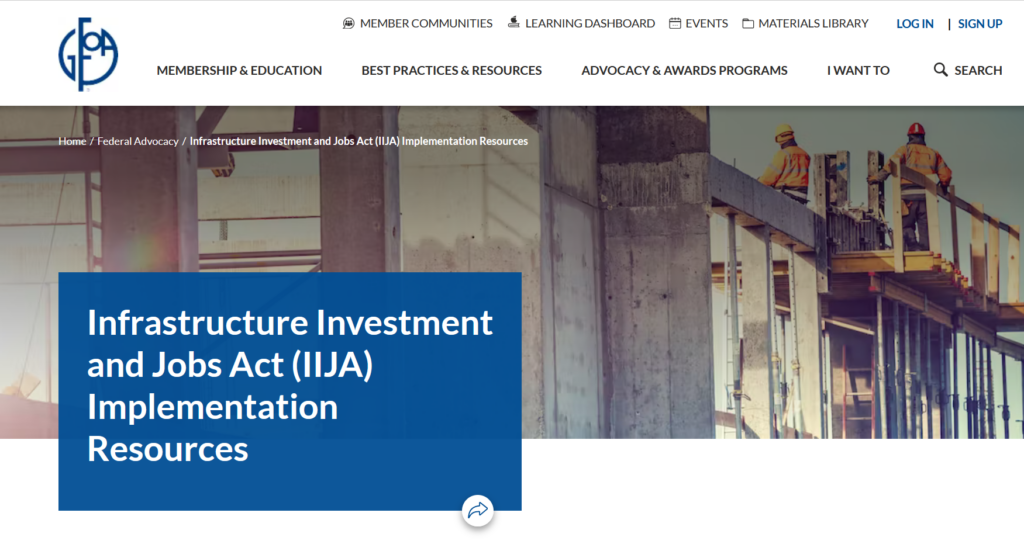The Infrastructure Investment and Jobs Act (IIJA), aka Bipartisan Infrastructure Law (BIL), was signed into law by President Biden in late 2021. The law authorizes over $1 trillion for transportation and infrastructure spending, with more than $500 billion of which going toward new investments and programs. IIJA funding is broad, aiming to address a multitude of domestic infrastructure needs. Most notably, as related to the Environmental Finance Council Network and its stakeholders, the IIJA makes more than $50 billion available for water infrastructure related projects.
The Government Finance Officers Association’s (GFOA) Federal Liaison Center has published a comprehensive implementation resource page that breaks down the bill’s funding opportunities and other key information. It is completely free to use and provides valuable context surrounding the bill’s purpose, intent, and implementation. This will be the screen that should appear:
About three-quarters of the way down the page, a description and drop-down menu of funding opportunities related to water infrastructure can be found. It will look like this:
The IIJA includes a significant amount of funding for water infrastructure, including:
- $15 billion for lead service line replacement. This funding will be used to replace lead service lines, which are the pipes that connect water mains to homes and businesses. Lead service lines can leach lead into drinking water, which can cause a variety of health problems, especially in children.
- $5 billion for the Small and Underserved Communities Emerging Contaminants Grant Program. This funding will be used to help small and underserved communities finance the cost of complying with regulations on emerging contaminants, such as PFAS.
- More than $100 million for the Watershed Rehabilitation Program. This funding will be used to help rehabilitate dams and other water infrastructure in watersheds that are important for drinking water supply, recreation, and other purposes.
- $1.15 billion for the Water & Groundwater Storage, and Conveyance Program. This funding will be used to help states and local governments build new water storage and conveyance facilities, such as reservoirs and pipelines.
- $5 billion in grants for the Drinking Water State Revolving Fund – Emerging Contaminants ($4 billion) and the Clean Water State Revolving Fund – Emerging Contaminants ($1 billion) programs. These programs provide low-interest loans to water utilities to help them finance the cost of complying with regulations on emerging contaminants.
The funds being made available for the Small and Underserved Communities Emerging Contaminants Grant Program, the Drinking Water State Revolving Fund, and the Clean Water State Revolving Fund each specifically name polyfluoroalkyl substances (PFAS) as an emerging contaminant that is eligible to address with such federal money. This aligns with the Biden-Harris Administration’s decision to propose a national drinking water standard for six identified PFAS in March of this year. PFAS are human-made chemicals that can be found in air, water and food that cause cancer and other severe health problems. PFAS pollution poses a serious threat to all citizens and disproportionately affects underserved communities.
GFOA’s IIJA resource page also includes links to the White House’s “IIJA Guidebook” and “IIJA Guidebook Rural Playbook.” The former is broader in its outline of the infrastructure package, while the latter is more acutely focused on the needs of rural communities. Further information about other infrastructure opportunities the bill seeks to address can also be found on the same link; Other focus areas include transportation projects, expanding broadband access and community resiliency. Funding opportunities under this bill, for water infrastructure and other qualifying projects, are being publicized on the page’s “Notice of Funding Opportunity (NOFO) Tracker.” Additionally, the page explains “Requirements to Consider” regarding IIJA funding, which encompasses descriptions of the Buy America, Build America Act (BABA) and the Justice40 initiative.



